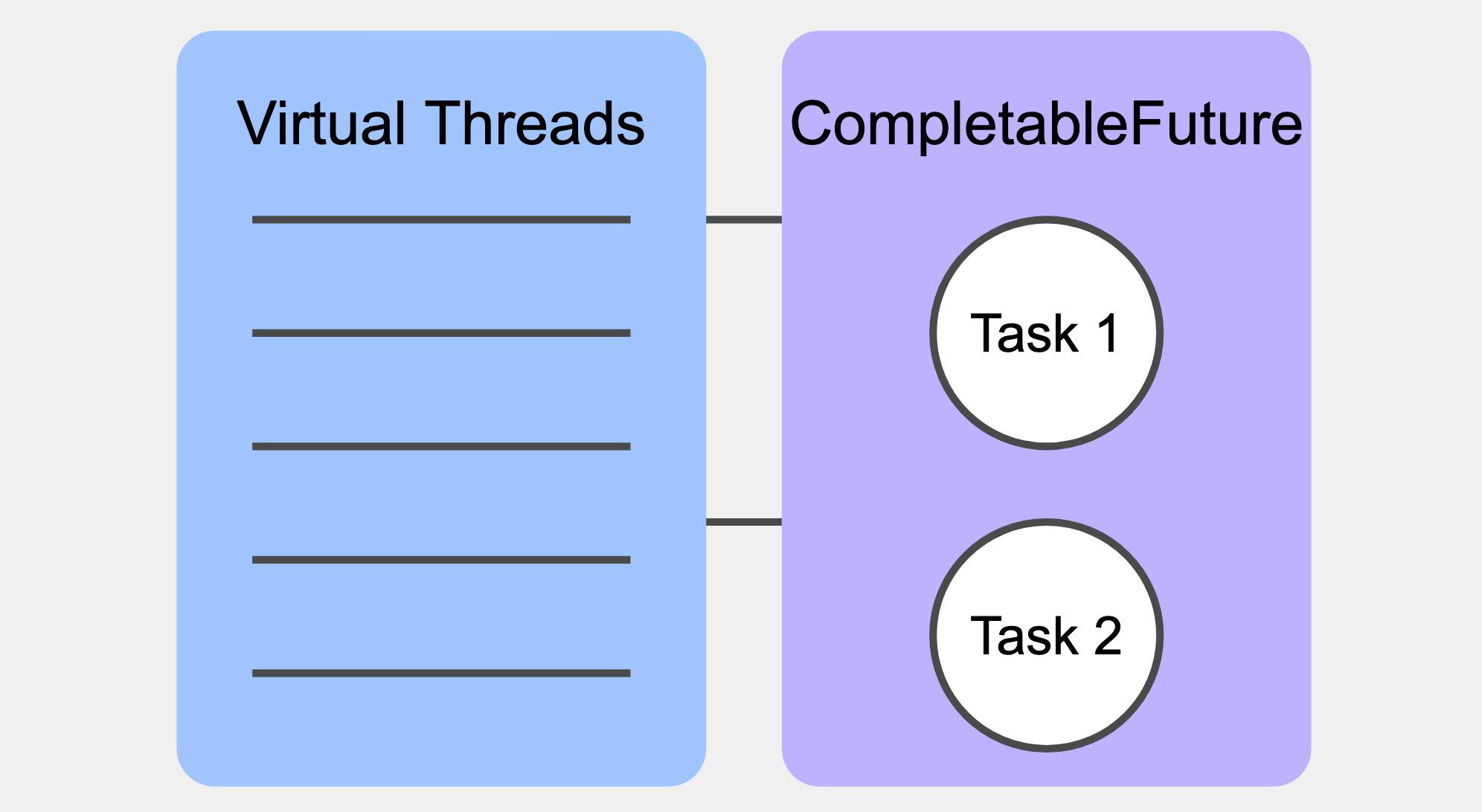
Simplifying Concurrency in Java
Virtual Threads and CompletableFuture
In the world of modern software development, handling multiple tasks simultaneously is crucial for creating responsive and efficient applications. On the other hand, concurrent programming is undeniably hard.
Java, one of the most popular programming languages, has recently introduced new features to make concurrent programming easier and more efficient. In this blog post, we'll explore the combination of two powerful tools: Virtual Threads together with CompletableFuture.
Understanding Concurrency: A Simple Analogy
Before we dive into the technical details, let's consider a simple analogy. Imagine you're managing a busy restaurant kitchen. Each chef is like a thread in a computer program, capable of working on different dishes simultaneously. Traditional threads in Java are like having a limited number of full-time chefs – they're powerful but expensive to maintain, and you can only have so many.
Enter Virtual Threads: The Kitchen Helpers
Virtual threads, introduced in Java 21, are like having an unlimited supply of part-time kitchen helpers. They're lightweight, easy to create, and perfect for tasks that involve a lot of waiting (like waiting for an oven timer or, in computing terms, waiting for a database query to complete).
Key benefits of virtual threads:
- Lightweight: You can create thousands or even millions of them without overwhelming your system.
- Efficient for I/O operations: Perfect for tasks that spend a lot of time waiting, like network or database operations.
- Simplified coding: They make your concurrent code look more like straightforward, sequential code.
CompletableFuture: The Recipe Card System
If virtual threads are our kitchen helpers, CompletableFuture is like a sophisticated recipe card system. It allows you to describe complex sequences of operations, handle errors, and combine results from multiple tasks.
Key features of CompletableFuture:
- Chaining operations: Easily describe sequences of asynchronous operations.
- Error handling: Built-in mechanisms to handle exceptions in asynchronous code.
- Combining results: Coordinate multiple parallel operations and combine their results.
Putting It All Together: A Kitchen in Action
Let's look at a simple example of how these technologies work together:
import java.util.concurrent.CompletableFuture;
import java.util.concurrent.ExecutorService;
import java.util.concurrent.Executors;
public class RestaurantKitchen {
public static void main(String[] args) {
// Open our kitchen with virtual thread helpers
try (ExecutorService kitchen = Executors.newVirtualThreadPerTaskExecutor()) {
// Prepare 100 dishes asynchronously
CompletableFuture<String>[] dishes = new CompletableFuture[100];
for (int i = 0; i < 100; i++) {
final int dishNumber = i;
dishes[i] = CompletableFuture.supplyAsync(() -> {
prepareDish(dishNumber);
return "Dish " + dishNumber + " is ready!";
}, kitchen);
}
// Wait for all dishes to be ready
CompletableFuture.allOf(dishes).join();
// Serve the dishes
for (CompletableFuture<String> dish : dishes) {
System.out.println(dish.join());
}
}
}
private static void prepareDish(int dishNumber) {
System.out.println("Preparing dish " + dishNumber + " in " + Thread.currentThread());
// Simulate cooking time
try {
Thread.sleep(100);
} catch (InterruptedException e) {
Thread.currentThread().interrupt();
}
}
}In this example:
- We create a "kitchen" using virtual threads.
- We start preparing 100 dishes simultaneously, each as a separate task.
- We use CompletableFuture to manage these tasks and wait for all of them to complete.
- Finally, we "serve" (print) the results of each dish preparation.
Why This Matters
This approach allows us to handle a large number of concurrent operations efficiently. In a real-world scenario, instead of preparing dishes, we might be handling web requests, processing data, or performing database operations.
The combination of virtual threads and CompletableFuture allows us to write clear, efficient code that can handle thousands of operations concurrently without overwhelming our system resources.
Conclusion
Java's virtual threads and CompletableFuture provide a powerful toolkit for writing concurrent applications. They allow developers to create highly scalable systems with code that's easier to write and understand. Whether you're building a small application or a large-scale system, these tools can help you make the most of modern hardware and create responsive, efficient software.
Remember, like any powerful tool, these features require practice and understanding to use effectively. But with these basics, you're well on your way to mastering concurrent programming in Java!
